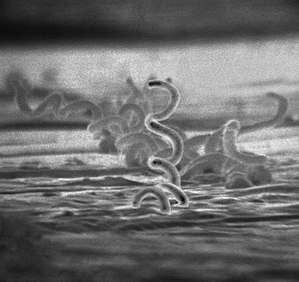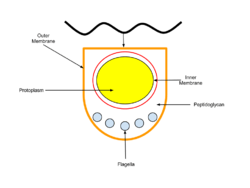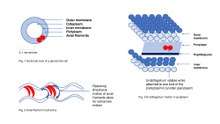Spirochaete
A spirochaete (/ˈspaɪroʊˌkiːt/)[1] or spirochete is a member of the phylum Spirochaetes (/-ˈkiːtiːz/),[2] which contains distinctive diderm (double-membrane) bacteria, most of which have long, helically coiled (corkscrew-shaped or spiraled, hence the name) cells.[3] Spirochaetes are chemoheterotrophic in nature, with lengths between 3 and 500 μm and diameters around 0.09 to at least 3 μm.[4]
| Spirochaetes | |
|---|---|
 | |
| Treponema pallidum spirochaetes which cause syphilis | |
| Scientific classification | |
| Domain: | |
| (unranked): | |
| Phylum: | Spirochaetes Garrity & Holt 2001 |
| Class: | Spirochaetia Paster 2011 |
| Orders & Families | |
| |
| Synonyms | |
| |


Spirochaetes are distinguished from other bacterial phyla by the location of their flagella, sometimes called axial filaments, which run lengthwise between the bacterial inner membrane and outer membrane in periplasmic space. These cause a twisting motion which allows the spirochaete to move about. When reproducing, a spirochaete will undergo asexual transverse binary fission. Most spirochaetes are free-living and anaerobic, but there are numerous exceptions. Spirochaetes bacteria are diverse in their pathogenic capacity and the ecological niches that they inhabit, as well as molecular characteristics including guanine-cytosine content and genome size.[5][6]
Pathogenicity
Many organisms within the Spirochaetes phylum cause prevalent diseases. Pathogenic members of this phylum include the following:
- Leptospira species, which causes leptospirosis[7]
- Borrelia burgdorferi, B. garinii, and B. afzelii, which cause Lyme disease
- Borrelia recurrentis, which causes relapsing fever[8]
- Treponema pallidum subspecies which cause treponematoses such as syphilis and yaws.
- Brachyspira pilosicoli and Brachyspira aalborgi, which cause intestinal spirochaetosis[9]
Spirochaetes may also cause dementia and may be involved in the pathogenesis of Alzheimer's disease.[10] Salvarsan, the first partially organic synthetic antimicrobial drug in medical history, was effective against spirochaetes only and was primarily used to cure syphilis.
Taxonomy and molecular signatures
The class currently consists of 14 validly named genera across 4 orders and 5 families.[11][12][13] The orders Brachyspirales, Brevinematales and Leptospirales each contain a single family, Brachyspiraceae, Brevinemataceae and Leptospiraceae, respectively. The Spirochaetales order harbours two families, Spirochaetaceae and Borreliaceae. Molecular markers in the form of conserved signature indels (CSIs) and CSPs have been found specific for each of the orders, with the exception of Brevinimetales, that provide a reliable means to demarcate these clades from one another within the diverse phylum.[12] Additional CSIs have been found exclusively shared by each family within the Spirochaetales. These molecular markers are in agreement with the observed phylogenetic tree branching of two monophyletic clades within the Spirochaetales order.[12] CSIs have also been found that further differentiate taxonomic groups within the Borreliaceae family that further delineate evolutionary relationships that are in accordance with physical characteristics such as pathogenicity (viz. Borrelia emend. Borreliella gen. nov.).[14] However, this study has been criticized, and other studies using different approaches do not support the proposed split.[15] The new naming system for the Lyme and relapsing fever Borrelia has not been adopted by the scientific literature.[15]
A CSI has also been found exclusively shared by all Spirochaetes species.[12] This CSI is a 3 amino acid insert in the flagellar basal body rod protein FlgC which is an important part of the unique endoflagellar structure shared by Spirochaetes species.[16] Given that the CSI is exclusively shared by members within this phylum, it has been postulated that it may be related to the characteristic flagellar properties observed among Spirochaetes species.[12][16]
Historically, all families belonging to the Spirochaetes phylum were assigned to a single order, the Spirochaetales.[5][6] However, the current taxonomic view is more connotative of accurate evolutionary relationships. The distribution of a CSI is indicative of shared ancestry within the clade for which it is specific. It thus functions as a synapomorphic characteristic, so that the distributions of different CSIs provide the means to identify different orders and families within the phylum and so justify the phylogenetic divisions.[12]
Phylogeny
The phylogeny is based on 16S rRNA-based LTP release 132 by The All-Species Living Tree Project.[17]
| |||||||||||||||||||||||||||||||||||||||||||||||||||||||||||||||||||||||||||||||||||||||||||||||||||||||||||||
Taxonomy
The currently accepted taxonomy is based on the List of Prokaryotic names with Standing in Nomenclature (LPSN)[18] and National Center for Biotechnology Information (NCBI).[19]
- Phylum Spirochaetes Garrity & Holt 2001 [Spirochaetae Cavalier-Smith 2002; Spirochaetaeota Oren et al. 2015]
- Class Spirochaetae Cavalier-Smith 2002 ["Protozoobacteriales"; "Spirochaetia" Paster 2011]
- Order Leptospirales Gupta et al. 2014
- Family Leptospiraceae Hovind-Hougen 1979 emend. Levett et al. 2005
- Genus Leptonema Hovind-Hougen 1983
- Genus Leptospira Noguchi 1917 emend. Faine and Stallman 1982
- Genus Turneriella Levett et al. 2005 ["Turneria" Hookey, Bryden & Gatehouse 1993 non-Forel 1895]
- Family Leptospiraceae Hovind-Hougen 1979 emend. Levett et al. 2005
- Order Brachyspirales corrig. Gupta et al. 2014
- Family Brachyspiraceae Paster 2012
- Genus Brachyspira Hovind-Hougen et al. 1982 [Serpula Stanton et al. 1991 non Linnaeus 1758; Serpulina Stanton 1992 non Zborzevski 1834]
- Family Brachyspiraceae Paster 2012
- Order Brevinematales Gupta et al. 2014
- Family Brevinemataceae Paster 2012
- Genus Brevinema Defosse et al. 1995
- Family Brevinemataceae Paster 2012
- Order Spirochaetales Buchanan 1917 emend. Gupta et al. 2013
- Genus Exilispira Imachi et al. 2008
- Genus Alkalispirochaeta Sravanthi et al. 2016
- Genus Oceanispirochaeta Subhash & Lee 2017b
- Genus Pleomorphochaeta Arroua et al. 2016
- Genus Sediminispirochaeta Shivani et al. 2016
- Genus Sphaerochaeta Ritalahti et al. 2012 emend. Miyazaki et al. 2014
- Family Borreliaceae Gupta et al. 2014
- Genus Borrelia Swellengrebel 1907 emend. Adeolu & Gupta 2014, emend. Margos et al. 2018 (relapsing fever Borrelia, Lyme borreliosis Borrelia, reptile-associated Borrelia and Echidna-associated Borrelia)
- Genus Cristispira pectinis Gross 1910
- Family Spirochaetaceae Swellengrebel 1907
- Genus ?Clevelandina reticulitermitidis ♦ Bermudes et al. 1988
- Genus ?Diplocalyx calotermitidis ♦ (ex Gharagozlou 1968) Bermudes et al. 1988
- Genus ?Hollandina pterotermitidis ♦ (ex To et al. 1978) Bermudes et al. 1988
- Genus ?Pillotina calotermitidis ♦ (ex Hollande and Gharagozlou 1967) Bermudes et al. 1988
- Genus Marispirochaeta Shivani et al. 2017
- Genus Spirochaeta Ehrenberg 1835 emend. Pikuta et al. 2009 ["Ehrenbergia" Gieszczykiewiez 1939 non-Spreng.; incl. Salinispira Ben Hania et al. 2015]
- Genus Treponema Schaudinn 1905 emend Abt et al. 2013 ["Spironema" Vuillemin 1905 non-Klebs 1892; "Microspironema" Stiles & Pfender 1905; incl. Rectinema Koelschbach et al. 2017]
- Order Leptospirales Gupta et al. 2014
- Class Spirochaetae Cavalier-Smith 2002 ["Protozoobacteriales"; "Spirochaetia" Paster 2011]
Notes:
♦ Type strain lost or not available
♪ Prokaryotes where no pure (axenic) cultures are isolated or available, i.e. not cultivated or can not be sustained in culture for more than a few serial passages
♠ Strains found at the National Center for Biotechnology Information (NCBI) but not listed in the List of Prokaryotic names with Standing in Nomenclature (LSPN)
See also
References
- spirochaete - Oxford Dictionaries
- Elsevier, Dorland's Illustrated Medical Dictionary, Elsevier.
- Ryan KJ; Ray CG (editors) (2004). Sherris Medical Microbiology (4th ed.). McGraw Hill. ISBN 978-0-8385-8529-0.CS1 maint: extra text: authors list (link)
- Margulis, L.; Ashen, J. B.; Solé, M.; Guerrero, R. (1 August 1993). "Composite, large spirochetes from microbial mats: spirochete structure review" (PDF). Proceedings of the National Academy of Sciences. 90 (15): 6966–6970. Bibcode:1993PNAS...90.6966M. doi:10.1073/pnas.90.15.6966. ISSN 0027-8424. PMC 47056. PMID 8346204.
- Paster BJ (2011) Phylum XV. Spirochaetes Garrity and Holt. In: Bergey’s Manual of Systematic Bacteriology, pp. 471. Eds D.J. Brenner, N.R.Krieg, G.M.Garrity, and J.T. Staley Springer-: New York.
- Paster BJ (2011) Family I. Sprochaetes Swellengrebel 1907, 581AL. In: Bergey’s Manual of Systematic Bacteriology, pp. 473–531. Eds D.J. Brenner, N.R.Krieg, G.M.Garrity, and J.T. Staley Springer-: New York.
- McBride A, Athanazio D, Reis M, Ko A (2005). "Leptospirosis". Current Opinion in Infectious Diseases. 18 (5): 376–86. doi:10.1097/01.qco.0000178824.05715.2c. PMID 16148523.
- Schwan T (1996). "Ticks and Borrelia: model systems for investigating pathogen-arthropod interactions". Infect Agents Dis. 5 (3): 167–81. PMID 8805079.
- Amat Villegas I, Borobio Aguilar E, Beloqui Perez R, de Llano Varela P, Oquiñena Legaz S, Martínez-Peñuela Virseda JM (January 2004). "[Colonic spirochetes: an infrequent cause of adult diarrhea]". Gastroenterol Hepatol (in Spanish). 27 (1): 21–3. doi:10.1016/s0210-5705(03)70440-3. PMID 14718105.
- Miklossy, Judith (4 August 2011). "Alzheimer's disease - a neurospirochetosis. Analysis of the evidence following Koch's and Hill's criteria". Journal of Neuroinflammation. 8: 90. doi:10.1186/1742-2094-8-90. ISSN 1742-2094. PMC 3171359. PMID 21816039.
- Sayers; et al. "TherSpirochaetia". National Center for Biotechnology Information (NCBI) taxonomy database. Retrieved 25 October 2016.
- Gupta RS, Mahmood S, Adeolu M (2013). "A phylogenomic and molecular signature based approach for characterization of the phylum Spirochaetes and its major clades: proposal for a taxonomic revision of the phylum". Front Microbiol. 4 (217): 217. doi:10.3389/fmicb.2013.00217. PMC 3726837. PMID 23908650.
- Oren A, Garrity GM (2014). "List of new names and new combinations previously effectively, but not validly, published" (PDF). Int. J. Syst. Evol. Microbiol. 64 (3): 693–696. doi:10.1099/ijs.0.062521-0.
- Adeolu M, Gupta RS (2014). "A phylogenomic and molecular marker based proposal for the division of the genus Borrelia into two genera: the emended genus Borrelia containing only the members of the relapsing fever Borrelia, and the genus Borreliella gen. nov. containing the members of the Lyme disease Borrelia (Borrelia burgdorferi sensu lato complex)". Antonie van Leeuwenhoek. 105 (6): 1049–1072. doi:10.1007/s10482-014-0164-x. PMID 24744012.
- Winslow C, Coburn J (2019). "Recent discoveries and advancements in research on the Lyme disease spirochete Borrelia burgdorferi". F1000Research. 8: 763. doi:10.12688/f1000research.18379.1. PMC 6545822. PMID 31214329.
- Macnab RM (2003). "How bacteria assemble flagella". Annu Rev Microbiol. 57: 77–100. doi:10.1146/annurev.micro.57.030502.090832. PMID 12730325.
- "16S rRNA-based LTP release 132 (full tree)". All-Species Living Tree Project. Silva Comprehensive Ribosomal RNA Database. Retrieved 20 July 2018.
- J.P. Euzéby. "Spirochaetes". List of Prokaryotic names with Standing in Nomenclature (LPSN). Retrieved 20 July 2018.
- Sayers; et al. "Spirochaetes". National Center for Biotechnology Information (NCBI) taxonomy database. Retrieved 20 July 2018.
External links
- Introduction to the Spirochetes University of California Museum of Paleontology (UCMP)